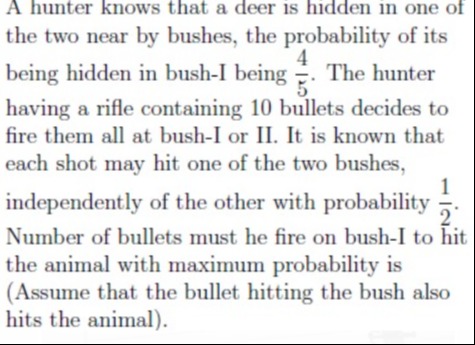Question
Question: A hunter knows that a deer is hidden in one of the two near by bushes, the probability of its being ...
A hunter knows that a deer is hidden in one of the two near by bushes, the probability of its being hidden in bush-I being 54. The hunter having a rifle containing 10 bullets decides to fire them all at bush-I or II. It is known that each shot may hit one of the two bushes, independently of the other with probability 21. Number of bullets must he fire on bush-I to hit the animal with maximum probability is (Assume that the bullet hitting the bush also hits the animal).

6
Solution
We first note that the deer is in bush‑I with probability
PI=54and in bush‑II with probability
PII=51.If the hunter fires x bullets at bush‑I and (10−x) bullets at bush‑II, then each bullet (independently) hits its chosen bush with probability 21. Hence, the probability that at least one bullet hits bush‑I is
1−(21)x,and similarly, the probability that at least one bullet hits bush‑II is
1−(21)10−x.Thus, the overall probability P of hitting the deer is
P(x)=54[1−(21)x]+51[1−(21)10−x].Since the overall constant “1” does not affect maximization, we need to minimize
Q(x)=54(21)x+51(21)10−x.To find the optimal x, we consider x as a continuous variable and differentiate Q(x) with respect to x.
Express the terms using exponentials:
(21)x=e−xln2and(21)10−x=e−(10−x)ln2=e−10ln2exln2.Thus,
Q(x)=54e−xln2+51e−10ln2exln2.Differentiate:
dxdQ=54(−ln2)e−xln2+51e−10ln2(ln2)exln2.Set dxdQ=0:
−54ln2e−xln2+51ln2e−10ln2exln2=0.Cancel 51ln2 (which is nonzero) to obtain:
−4e−xln2+e−10ln2exln2=0.Rearrange:
e−10ln2exln2=4e−xln2.Divide both sides by e−xln2:
e−10ln2e2xln2=4.This is equivalent to:
e(2x−10)ln2=4⇒22x−10=4.Since 4=22, we have:
2x−10=2⇒2x=12⇒x=6.Thus, the hunter should fire 6 bullets at bush‑I (and the remaining 4 at bush‑II) to maximize the probability of hitting the deer.
